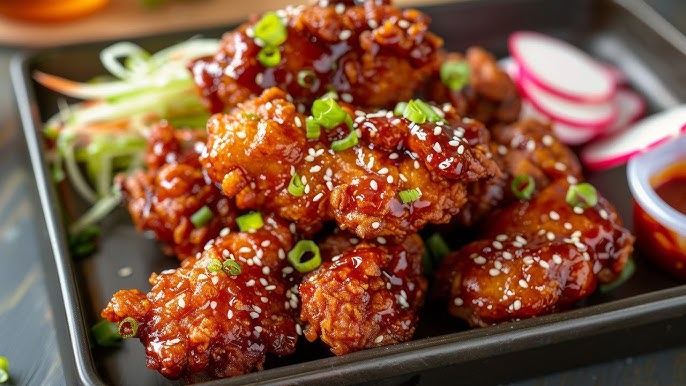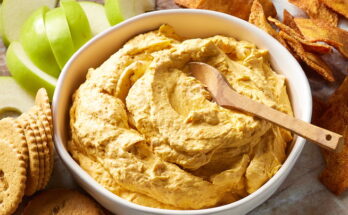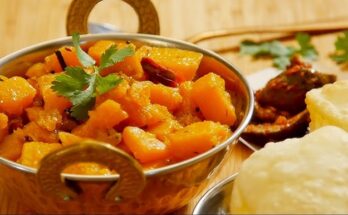Korean Chicken Recipe: Korean chicken isn’t just food—it’s an experience. Whether it’s the sweet, sticky, spicy glory of yangnyeom chicken or the perfectly crisp skin of Korean fried chicken, every bite packs a punch. Korean chicken is all about balance—crispy textures, bold flavors, and sauces that make your taste buds dance.
In this guide, we’re diving deep into how to make authentic Korean chicken right at home. You don’t need to fly to Seoul or be a professional chef to nail this dish. We’re talking real, easy-to-follow steps that’ll take you from chicken novice to K-chicken master. Whether you’re planning a weeknight dinner or prepping for a party, this recipe has your back.
Why should you make Korean chicken at home? First, it’s way more affordable than takeout. Second, it lets you tweak flavors to your liking—more heat, less sweet, you name it. Lastly, it’s fun! Watching your chicken go from raw to crispy golden brown and finally coated in a glossy, flavor-loaded sauce is deeply satisfying.
Ready to bring some Korean magic into your kitchen? Let’s do this, step-by-step.
Ingredients You’ll Need
Before we turn up the heat, let’s gather everything you need. The beauty of this recipe lies in its simplicity—common ingredients come together to create something extraordinary. Here’s a list that balances authenticity and accessibility.
Main Ingredients:
- 2 lbs (900g) chicken wings or drumettes
- 1 tsp salt
- 1 tsp black pepper
- 1 tbsp garlic powder
- 1 cup cornstarch or potato starch (for extra crispiness)
- 1 egg (optional, helps bind starch)
For the Sauce:
- 4 tbsp gochujang (Korean red chili paste)
- 2 tbsp soy sauce
- 2 tbsp honey or corn syrup
- 1 tbsp brown sugar
- 1 tbsp rice vinegar
- 2 cloves garlic (minced)
- 1 tsp sesame oil
- 1 tbsp water (to adjust consistency)
- Sesame seeds (for garnish)
- Chopped green onions (optional, for garnish)
Optional Additions:
- Ginger (grated, for extra aroma)
- Crushed red pepper flakes (for added heat)
- Ketchup (to add a tangy base)
If you can’t find gochujang, try blending sriracha with a bit of miso paste and sugar as a substitute. However, for true flavor, sourcing authentic gochujang is worth it.
Ingredient prep is key. Chop, measure, and organize everything before cooking. Trust me, it’ll make the cooking process smooth and enjoyable.
Tools and Equipment
Good cooking doesn’t demand fancy gear. Here’s what you’ll need to cook Korean chicken like a pro at home.
Essential Tools:
- Deep fryer or a deep, heavy-bottomed pot
- Wire rack or paper towels (for draining)
- Large mixing bowl
- Tongs or chopsticks (for turning chicken)
- Whisk (for mixing the sauce)
- Measuring spoons and cups
If you have a thermometer, that’s great. It’ll help you keep the oil at the perfect frying temp (around 350°F or 175°C). If not, a wooden chopstick can help—dip it in oil and look for bubbles around it to know when the oil’s hot enough.
Cleanliness matters, especially when dealing with raw poultry. Keep separate cutting boards for meat and veggies, wash your hands often, and don’t reuse utensils used for raw chicken.
Preparing the Chicken
This step is all about setting the stage for crispy, flavorful bites. It starts with the right prep work.
Step 1: Cleaning & Cutting
Start by washing the chicken under cold water. Pat them dry thoroughly with paper towels—moisture is the enemy of crispiness.
If you’re using wings, consider separating them into drumettes and flats. For larger cuts like thighs or breasts, cut into smaller, bite-sized pieces to ensure even cooking.
Step 2: Seasoning
Toss your chicken pieces in salt, pepper, and garlic powder. Let them sit for about 10–15 minutes at room temperature. This allows the seasonings to penetrate a bit and brings the chicken closer to cooking temperature.
Step 3: Coating
Here’s where the magic starts. Coat the chicken evenly in cornstarch or potato starch. This creates that signature ultra-crispy crust Korean chicken is known for. Add an egg to the mix if you like it extra crunchy—it helps the starch stick better.
Don’t overcrowd the bowl; work in batches to make sure each piece gets an even coat.
Making the Signature Korean Sauce
The sauce is where the flavor lives. It’s sweet, spicy, and utterly addictive. Making it from scratch lets you control the balance just how you like it.
Step 1: Combine Ingredients
In a small bowl, whisk together:
- 4 tbsp gochujang
- 2 tbsp soy sauce
- 2 tbsp honey or corn syrup
- 1 tbsp brown sugar
- 1 tbsp rice vinegar
- 2 minced garlic cloves
- 1 tsp sesame oil
- 1 tbsp water
If you want it extra spicy, add crushed red pepper or a dash of cayenne. Like it tangy? Up the vinegar just a bit. This sauce is flexible.
Step 2: Simmer the Sauce
Pour the mix into a small saucepan and simmer over medium heat. Stir frequently to avoid burning the sugars. After 3–5 minutes, the sauce will thicken and become glossy.
Pro tip: Don’t overcook—once it coats the back of a spoon, it’s ready. Let it cool slightly before tossing it with the fried chicken. Hot sauce on hot chicken = flavor explosion.
Frying the Chicken to Crispy Perfection
Here comes the most satisfying part—getting that golden, ultra-crunchy texture that makes Korean chicken legendary. The secret? Double frying. It may sound tedious, but the results are worth every minute.
Step 1: Heat the Oil
Pour oil into a deep pot or fryer—enough to submerge the chicken pieces fully. Heat the oil to about 340–350°F (170–175°C). Use a thermometer if you have one. If not, the wooden chopstick trick works: if bubbles rapidly form around the stick, the oil’s ready.
Step 2: First Fry
Carefully place the coated chicken into the hot oil using tongs. Don’t overcrowd the pot—fry in batches. Each batch should take 6–8 minutes depending on the size of your pieces.
Once golden and cooked through, transfer the chicken to a wire rack or a plate lined with paper towels. Let it rest for 5–10 minutes. This pause is crucial—it allows moisture to escape and prepares the chicken for round two.
Step 3: Second Fry
Raise the oil temperature slightly to 375°F (190°C). Fry the chicken again, this time for 2–4 minutes, just until it’s extra crispy. You’ll see and hear the difference—the crust becomes more rigid, golden, and crinkly.
Double frying isn’t optional in Korean chicken—it’s essential. It removes extra oil and boosts crunch to a whole new level.
Tossing the Chicken in Sauce
This is where everything comes together. Sauce meets crunch, and magic happens.
Step 1: Sauce Tossing Tips
Place the hot, double-fried chicken in a large bowl. Pour the warm sauce over the top—just enough to coat. Use tongs or toss by hand (wear gloves!) to ensure every piece gets an even layer of that sticky, spicy goodness.
You want the sauce to coat the chicken, not drown it. Aim for a glossy sheen rather than a soupy puddle.
Step 2: Final Garnishes
Sprinkle toasted sesame seeds over the chicken for that nutty aroma. Add finely chopped green onions or chives for freshness and a pop of color. If you want it restaurant-style, serve with pickled radish and a cold beer on the side.
The first bite will be hot, sweet, spicy, and irresistibly crunchy. You’ve just made real-deal Korean chicken. Pat yourself on the back!
Serving Suggestions and Side Dishes
Korean chicken isn’t just a solo act—it shines brightest with a full cast of sides. Let’s explore how to turn this into a complete Korean-style meal.
Popular Korean Side Dishes (Banchan):
- Pickled Radish (Chikin-Mu): Slightly sweet, tangy cubes of radish that cut through the richness of fried chicken.
- Kimchi: The fermented favorite brings a tangy, spicy punch that balances the flavors.
- Steamed Rice: A neutral base that soaks up extra sauce beautifully.
- Coleslaw or Cabbage Salad: Light and crunchy to contrast the heaviness of fried foods.
- Corn Cheese: A sweet and savory treat made with corn, mayo, and melted cheese.
Want to go fusion? Serve your Korean chicken in tacos, wraps, or over waffles for a K-BBQ brunch twist. Sky’s the limit!
Tips for Storing and Reheating Korean Chicken
While Korean chicken is best eaten fresh, you can still enjoy it the next day with some hacks.
Storage Tips:
- Store chicken and sauce separately, if possible.
- Use an airtight container for the chicken and keep it in the fridge for up to 3 days.
Reheating Tips:
- Oven or air fryer is best for crispiness—heat at 375°F (190°C) for 10–15 minutes.
- Avoid microwaving as it makes the crust soggy.
- Reheat the sauce separately and toss again before serving.
If you’re planning to serve leftovers, consider making extra sauce fresh. It revives the dish like nothing else.
Common Mistakes and How to Avoid Them
Let’s avoid the rookie errors that can sabotage your Korean chicken.
1. Not Patting Chicken Dry
Moisture is the enemy of crispiness. Always dry chicken with paper towels before seasoning or coating.
2. Skipping the Double Fry
Yes, it’s extra work. But single-fried chicken loses its crunch fast. Double frying keeps it crispy even after saucing.
3. Overcrowding the Fryer
Too much chicken lowers the oil temp, causing greasy, undercooked bites. Fry in small batches.
4. Sauce Too Thick or Thin
If your sauce is gloopy, add water. If it’s too runny, simmer a bit longer. Aim for a pourable but clingy texture.
5. Using the Wrong Starch
Flour makes chicken cakey. Cornstarch or potato starch gives that crisp, crackly texture you want.
Variations of Korean Chicken
Korean chicken isn’t a one-size-fits-all dish. Depending on your taste preferences, you can tweak the base recipe to make entirely new flavor experiences. Let’s look at some popular variations.
1. Yangnyeom Chicken (Spicy-Sweet)
This is the most iconic style. The sauce is a fiery blend of gochujang, garlic, and sugar—perfect for those who love bold, balanced flavors. You’ve already made this if you followed the base recipe!
2. Honey Butter Chicken
Swap the spicy sauce for a smooth blend of butter, honey, and garlic. This variation is especially popular with kids and those who prefer a milder flavor.
To make the sauce:
- 2 tbsp butter
- 2 tbsp honey
- 1 minced garlic clove
- Pinch of salt
Melt everything together, then toss it with fried chicken. Sweet, salty, buttery perfection!
3. Soy Garlic Chicken
If spice isn’t your thing, go for soy garlic. It’s savory, aromatic, and deeply umami.
Soy Garlic Sauce:
- 3 tbsp soy sauce
- 1 tbsp brown sugar
- 1 tbsp honey
- 1 tbsp minced garlic
- 1 tsp sesame oil
Simmer the ingredients until slightly thickened and pour over the chicken. This variation is a crowd-pleaser for all ages.
4. Cheesy Korean Chicken
Take a cue from Korean pubs—top spicy Korean chicken with shredded mozzarella and broil until bubbly. It’s spicy meets cheesy in all the right ways.
These variations prove there’s a Korean chicken for every mood and every person. Once you’ve mastered the base, play around with flavors and create your own signature dish.
Why Korean Chicken Is So Addictive
So, what makes Korean chicken such a global phenomenon? It’s not just hype—it’s science, texture, and flavor all rolled into one.
The Crunch
Korean chicken’s double-fried crust is unlike Western fried chicken. It’s thinner, crispier, and stays crunchy longer. The secret lies in using starch instead of flour and frying twice.
The Sauce
Korean sauces are complex. They hit all five flavor notes: sweet, sour, salty, bitter, and umami. Gochujang, soy sauce, garlic, and sugar each bring their unique element, blending into a sauce that’s irresistible.
The Balance
Even though it’s deep-fried, Korean chicken doesn’t feel heavy. It’s balanced by vinegar in the sauce, fresh garnishes, and pickled sides, which keep your palate refreshed and craving more.
The Customization
From ultra-spicy to sticky-sweet, the variety of flavors available makes Korean chicken endlessly enjoyable. It adapts to different cuisines, fusions, and individual preferences.
FAQs about Korean Chicken Recipe
1. What is Korean chicken made of?
Korean chicken is typically made with chicken wings or drumsticks that are double-fried until crispy, then tossed in a sticky, flavorful sauce made of gochujang (Korean chili paste), soy sauce, garlic, ginger, sugar, and sesame oil.
2. Is Korean fried chicken very spicy?
Not always! While traditional Korean sauces can be spicy, you can adjust the heat level by reducing the amount of gochujang or adding honey to balance it out. There are also milder versions like soy garlic or honey butter chicken.
3. What makes Korean chicken different from regular fried chicken?
Korean chicken is double-fried, making it extra crispy with less grease. The sauces are also unique—bold, sweet, spicy, and often sticky—giving it that addictive Korean street food flavor.
4. Can I bake or air-fry Korean chicken instead of deep-frying?
Absolutely. While deep-frying gives the most authentic crunch, baking or air-frying is a healthier alternative. Just make sure to coat the chicken lightly with cornstarch or flour for crispiness.
5. What do you serve with Korean chicken?
Popular sides include pickled radish (chikin-mu), steamed rice, kimchi, or even coleslaw. It also pairs perfectly with a cold drink or Korean beer for that full K-drama vibe.
Conclusion
Korean chicken is more than a dish—it’s a full sensory experience. From the satisfying crunch of a double-fried crust to the rich depth of gochujang-based sauces, every bite tells a story of tradition, technique, and taste.
Whether you’re making yangnyeom, soy garlic, or honey butter, the beauty of this recipe is that it’s endlessly customizable. And once you’ve mastered the basic steps—marinate, coat, fry (twice!), sauce, and serve—you’ll be the go-to K-chicken chef among your friends and family.
The next time you crave comfort food with a punch, skip the delivery and head to your own kitchen. Korean chicken might just become your new favorite homemade meal.



